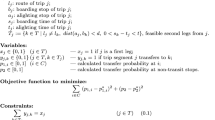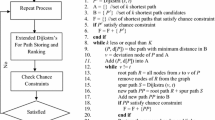Abstract
This paper deals with the transit passenger origin-destination (O-D) estimation problem by using updated passenger counts in congested transit networks and outdated prior O-D matrix. A bilevel programming approach is extended for the transit passenger O-D updating problem where the upper-level problem seeks to minimize the sum of error measurements in passenger counts and O-D matrices, while the lower level is the stochastic user equilibrium assignment problem for congested transit networks. The transit assignment framework is based on a frequency-adaptive transit network model in this paper, which can help determine transit line frequencies and the network flow pattern simultaneously in congested transit networks. A heuristic solution algorithm is adapted for solving the transit passenger O-D estimation problem. Finally, a numerical example is used to illustrate the applications of the proposed model and solution algorithm.
Similar content being viewed by others
References
Bell, M.G.H. (1991). “The Estimation of Origin-Destination Matrices by Constrained Generalized Least Squares.” Transportation Research, 25B, 13–22.
Bell, M.G.H. (1995). “Stochastic User Equilibrium Assignment in Networks with Queues.” Transportation Research, 29B, 125–137.
Cascetta, E. (1984). “Estimation of Trip Matrices from Traffic Counts and Survey Data: A Generalised Least Squares Estimator.” Transportation Research, 18B, 289–299.
Cea, J.D. and E. Fernández. (1993). “Transit Assignment for Congested Public Transport System: An Equilibrium Model.” Transportation Science, 27, 133–147.
Fisk, C.S. (1989). “Trip Matrix Estimation from Link Traffic Counts: The Congested Network Case.” Transportation Research, 23B, 331–336.
Florian, M. and Y. Chen. (1995). “A Coordinate Descent Method for the Bi-Level O-D Matrix Adjustment Problem.” International Transactions on Operations Research, 2, 165–179.
Lam, W.H.K. and J. Morrall. (1982). “Bus Passenger Walking Distances and Waiting Times: A Summer-Winter Comparison.” Transportation Quarterly, 36, 407–421.
Lam, W.H.K., C.Y. Cheung, and C.F. Lam. (1999). “A Study of Crowding Effects at Hong Kong Light Rail Transit Stations.” Transportation Research, 33A, 401–415.
Lam, W.H.K., J. Zhou, and Z.H. Sheng. (2002). “A Capacity Restraint Transit Assignment with Elastic Line Frequency.” Transportation Research, 36B, 919–938.
Lam, W.H.K., Z.Y. Gao, K.S. Chan, and H. Yang. (1999). “A Stochastic User Equilibrium Assignment Model for Congested Transit Networks.” Transportation Research, 33B, 1–18.
Maher, M.J. (1983). “Inferences on Trip Matrices from Observations on Link Volumes: A Bayesian Statistical Approach.” Transportation Research, 17B, 435–447.
Maher, M.J., X.Y. Zhang, and D.V. Vliet. (2001). “A Bi-Level Programming Approach for Trip Matrix Estimation and Traffic Count Problems with Stochastic User Equilibrium Link Flows.” Transportation Research, 35B, 23–40.
Nguyen, S., E. Morello, and S. Pallottino. (1989). “Discrete Time Dynamic Estimation Model for Passengers Origin/Destination Matrices on Transit Networks.” Transportation Research, 23B, 251–260.
Nielsen, O.A. (2000). “A Stochastic Transit Assignment Model Considering Differences in Passengers Utility Functions.” Transportation Research, 34B, 377–402.
Nuzzolo, A., F. Russo, and U. Crisalli. (2001). “A Doubly Dynamic Schedule-Based Assignment Model for Transit Networks.” Transportation Science, 35, 268–285.
Oppenheim, N. (1995). Urban Travel Demand Modeling: From Individual Choices to General Equilibrium. New York: John Wiley & Sons, Inc.
Spiess, H. and M. Florian. (1989). “Optimal Strategies: A New Assignment Model for Transit Network.” Transportation Research, 23B, 83–102.
Spiess, H. (1987). “A Maximum Likelihood Model for Estimating Origin-Destination Matrices.” Transportation Research, 21B, 395–412.
Tong, C.O. and S.C. Wong. (1999). “A Stochastic Transit Assignment Model Using a Dynamic Schedule-Based Network.” Transportation Research, 33B, 107–121.
Wirasinghe, S.C. and D. Szplett. (1984). “An Investigation of Passenger Interchange and Train Standing Time at LRT Stations: (ii) Estimation of Standing Time.” Journal of Advanced Transportation, 18, 13–24.
Wong, S.C. and C.O. Tong. (1998). “Estimation of Time-Dependent Origin-Destination Matrices for Transit Networks.” Transportation Research, 32B, 35–48.
Wu, J.H., M. Florian, and P. Marcotte. (1994). “Transit Equilibrium Assignment: A Model and Solution Algorithms.” Transportation Science, 28, 193–203.
Yang, H. (1995). “Heuristic Algorithms for the Bilevel Origin-Destination Matrix Estimation Problem.” Transportation Research, 29B, 231–242.
Yang, H., Q. Meng, and M.G.H. Bell. (2001). “Simultaneous Estimation of the Origin-Destination Matrices and Travel Cost Coefficient for Congested Networks in a Stochastic User Equilibrium.” Transportation Science, 35, 107–123.
Yang, H., T. Sasaki, Y. Iida, and Y. Asakura. (1992). “Estimation of Origin-Destination Matrices from Link Traffic Counts on Congested Networks.” Transportation Research, 26B, 417–434.
Yang, H., Y. Iida, and T. Sasaki. (1994). “The Equilibrium-Based Origin-Destination Matrix Estimation Problem.” Transportation Research, 28B, 23–33.
Author information
Authors and Affiliations
Corresponding author
Additional information
The work described in this paper was mainly supported by two research grants from the Research Grants Council of the Hong Kong Special Administrative Region (Project No. PolyU 5143/03E and PolyU 5040/02E).
Rights and permissions
About this article
Cite this article
Wu, Z.X., Lam, W.H.K. Transit passenger origin-destination estimation in congested transit networks with elastic line frequencies. Ann Oper Res 144, 363–378 (2006). https://doi.org/10.1007/s10479-006-0002-2
Published:
Issue Date:
DOI: https://doi.org/10.1007/s10479-006-0002-2




